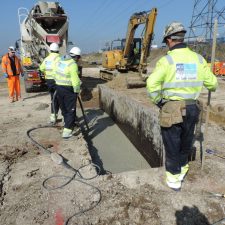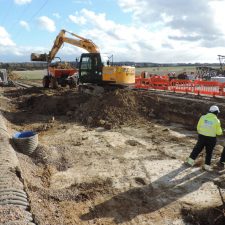Case Study: A5 M1 Link Road – Pylon Base Slab
Contractor: Costain
The A5 through Dunstable has long suffered from chronic congestion, which has had a significant effect on the towns and villages nearby. The A5-M1 Link is a vital scheme that seeks to relieve congestion on the A5, improve road safety and unlock economic growth in the area, enabling the development of 7000 houses and 40 hectares of employment land.
Ainsworth Civils were tasked with creating a new pylon base slab which required precision engineering to facilitate the exact fitting of the pylon to the slab. An error margin greater than 3mm would have required the entire base slab to be recreated from scratch.
CAT scan to confirm locations of underground drainage….
One week was spent setting up the welfare facilities to prepare for work to commence. This included scanning the area with a CAT scan to confirm locations of underground drainage, electric cables and gas mains. Once located, a trial hole was excavated by hand to confirm their depth and concrete and steel protection slabs were cast over the gas mains to carry the 100 tonne crane outriggers.
A perimeter fence was erected to ensure planned excavation work could proceed safely and to schedule. Excavation of the site commenced on time and proceeded without incident resulting in the base being ready for construction of the pylon reinforcement and formwork.
Due to the risk of working under high voltage overhead lines Ainsworth Civils had to ensure that any plant brought in had height restrictors fitted, maintaining a minimum three metres distance from live overhead wires at all times.
Ainsworth Civils also installed a lightning and earthing grid around the perimeter to ensure the continued safety and electrical integrity of the structure.
The stub locations were surveyed and resurveyed numerous times to ensure a perfect fit….
The pylon stubs were set in position and held in place using a bespoke frame provided by Ainsworth Civils. The stub locations were surveyed and resurveyed numerous times to ensure a perfect fit when the pylons were subsequently placed in their positions.
Following the stringent pre-pour check, concrete pouring could commence with ongoing surveys of the pylon stubs.
Once the concrete had cured, dismantling of the site involved reinstating and compacting the ground around the pylon base and finalising landscaping, allowing the main contractors to proceed with the next phase of the project on time.
As with every other project, Ainsworth Civils proudly maintained their flawless health and safety record, as well as delivering their consistently high quality.




